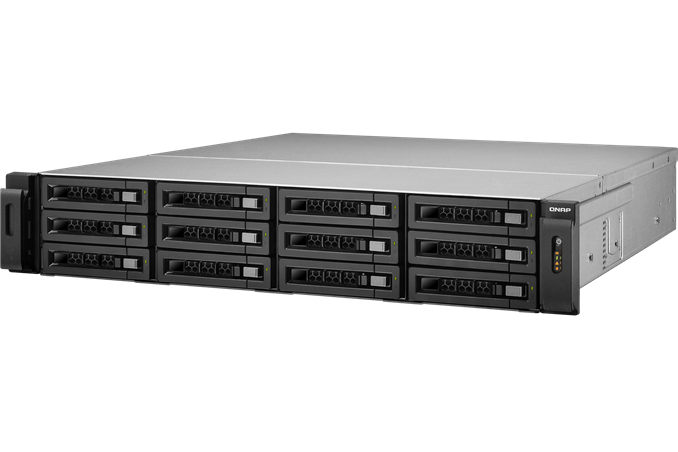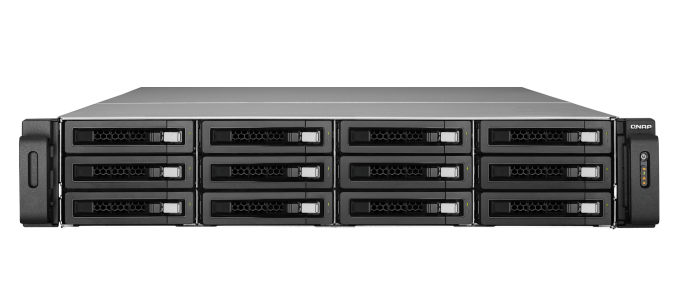QNAP's TS-EC1279U-RP 12-bay Flagship Rackmount NAS Review
by Ganesh T S on April 29, 2013 4:30 PM EST- Posted in
- Enterprise
- Storage
- NAS
- QNAP

Introduction
Our enterprise NAS reviews have focused on Atom-based desktop form factor systems till now. These units have enough performance for a moderately sized workgroup and lack some of the essential features in the enterprise space such as acceptable performance with encrypted volumes. A number of readers have mailed in asking for more coverage of the NAS market straddling the high-end NAS and the NAS - SAN (storage area network) hybrid space. Models catering to this space come in the rackmount form factor and are based on more powerful processors such as the Core series or the Xeon series.
QNAP's 12-bay flagship unit is the TS-EC1279U-RP. Based on the Xeon E3-1225 processor, this 2U rackmount system comes with twelve hot-swappable bays and 4GB of ECC RAM. Both SATA and SAS disks in 3.5" as well as 2.5" form factor are supported.
The last QNAP unit that we reviewed was the TS-659 Pro II. Around that time, QNAP was struggling with some data corruption issues in their firmware. We were hesitant to carry on reviewing QNAP's products while this issue remained outstanding. The solution came in the form of FW release v3.7.1 almost a year after the problem was first reported. We have been using a couple of QNAP units in-house with later firmware releases and couldn't replicate the bug in our environment. This gave us enough confidence to request QNAP for one of their latest NAS units. They obliged with the TS-1279U-RP, and it also marks our foray into reviewing units in the rackmount space.
The specifications of the TS-EC1279U-RP are as below:
| QNAP TS-EC1279U-RP Specifications | |
| Processor | Intel Xeon E3-1225 (4C, 3.1 GHz) |
| RAM | 4 GB DDR3 ECC RAM (Upgradable to 8 GB) |
| Flash | 512MB DOM |
| Drive Bays | 12x 3.5"/2.5" SATA / SAS 6 Gbps HDD / SSD |
| Network Links | 4x 1 GbE (Two links upgradable to 10 GbE) |
| USB Slots | 2x USB 3.0 / 4x USB 2.0 |
| eSATA Slots | 2x |
| Expansion Slots | 2x (Network or Storage Expansion) |
| VGA | Reserved for Maintenance |
| Full Specifications Link | QNAP TS-EC1279U-RP Hardware Specs |
In the rest of the review, I will cover some unboxing and setup impressions. A detailed description of the testbed setup and testing methodology is followed by performance numbers in both single and multi-client modes. As requested by multiple readers, we will also briefly cover performance with encryption enabled. In the final section, power consumption numbers as well as RAID rebuild times will be covered along with some closing notes.











23 Comments
View All Comments
mschira - Monday, April 29, 2013 - link
I was wondering if one could install a proper Linux on these systems, such as Fedora.Then one could use it as a medium powerful computation server with lot's of local storage.
Has anybody tried that?
Cheers
M.
watersb - Monday, April 29, 2013 - link
It's a bit late for coffee, so please forgive me for not finding a price in the review.This looks like an interesting product, but I'm a ZFS zealot. Running ZFS with only 4 GB RAM isn't going to fly.
That said, I am *very* interested in anything resembling a mid-range NAS. Storage is a real pain point, and it is tough to build acceptable storage out of cheap disks. So thanks for reviewing this thing!
ganeshts - Monday, April 29, 2013 - link
Price is $5K (MSRP), but retailers are selling it at prices ranging from $3500 to $5000davegraham - Tuesday, April 30, 2013 - link
Watersb,Use Nexenta Community Edition (uses OpenIndiana + ZFS) on top of a supermicro server with the same 12 drive bays (and SAS drives) and I'd kill this particular box AND have a more robust solution to boot.
D
watersb - Tuesday, April 30, 2013 - link
Thanks, Ganesh, for the pricing info.Dave, that's such a good idea, I switched to OpenIndiana in 2009. I'm running 8 2TB drives as four mirrored pairs with a $100 LSI controller. But it will be quite some time before I have the budget to upgrade to a server motherboard with more than 16GB ECC RAM.
ZFS deduplication is *expensive*, folks. Don't do it. I tried adding a 60Gb SSD for L2ARC but it turns out that I would be better off with 60GB of *swap* to hold the deduplication tables.
My kung fu is weak. But I've been running this system through numerous hardware failures, PEBKAC events, and system software updates, and I haven't lost any data. Solaris isn't bulletproof, but it does warn me of impending drive failures before I lose anything.
Sorry for the long rant -- but it IS possible to play with "enterprise" class system configurations on lousy hardware if you are willing to waste^W commit some time doing so.
Walkeer - Thursday, May 9, 2013 - link
I do not understand either why such powerful NAS has only 4GB or RAM looking at the RAM prices these days...davegraham - Monday, April 29, 2013 - link
can you please nix the usage of the word "enterprise" from your reviews? These QNAP boxes (and pretty much any other storage device y'all review these days) are Commercial, SMB, or Consumer level devices at best. Enterprise describes a category of business that would never use this based on uptime, data integrity, performance, and capability requirements.ganeshts - Monday, April 29, 2013 - link
Hmm.. Not sure why you are doubting the performance and capability of these units. With SSDs, they form a very good storage backend for medium sized work groups. Uptime and data integrity - These need more QA, but with the stable firmware version, I really had no trouble keeping it bombarded with data accesses for days togetherGigaplex - Monday, April 29, 2013 - link
Read your very own "cons" section. This is exactly why Enterprise wouldn't look at it. As for performance? I've got a dirt cheap home build Llano box using 5 WD Green drives in software RAID 5 and it easily reaches 250-300MB/s transfers. This system had 12 SSDs. Colour me underwhelmed.Walkeer - Thursday, May 9, 2013 - link
I understand you have 10Gb network at home right? Or InfiniBand 4x perhaps? Else I do not see how you push 300MBps over 1Gb line... or you are talking about your desktop? Man, this article is about NAS...